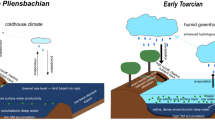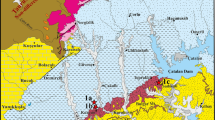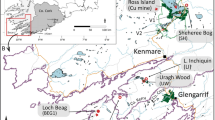Abstract
The timing of the last deglaciation in southern Chile is re-evaluated from a calendar varve chronology (Lago Puyehue, 40° S). The climate shifts are analysed by continuous annual varve-thickness measurements through the ∼17,100 cal. year to 10,800 cal. year BP time window (∼3.5 m sediment core). The varve years are determined by the alternation of light (phytoplankton-rich) and dark (terrigenous and organic-rich) layers forming graded annual couplets (∼0.2 to 0.8 mm/year). The varve chronology is constructed by conventional varve-counting methods on thin sections after correction for instantaneous volcanic and/or seismic events detected in the thin sections. The calibrated varve-age model derived from the manual varve counting is constrained by high-resolution grey-scale (GS) semi-automatic counts of the annual light phytoplankton-rich layers (∼120 μm to 300 μm thick). Due to physical sediment properties the GS constitutes a proxy record for the phytoplankton/terrigenous varve-thickness variations through the sediment record. The varve couplets are thicker/thinner during humid/dry phases and darker/lighter (negative/positive annual grey-scale index) during cold/warm phases. Our results show that at 40° S the last deglaciation took place in two phases between ∼17,100 cal. year and ∼15,500 cal. year BP. We note a climate instability between ∼15,500 cal. year and 13,300 cal. year BP and a significant dry phase between ∼15,000 and 14,500 cal. year BP. We evidence a cold event in two phases between ∼13,300 and 12,200 cal. year BP interrupted by a dry event between ∼12,800 and 12,600 cal. year BP. The onset of a significant warmer period is observed after ∼11,500 cal. year BP. Our results provide new evidence of a Younger Dryas cool reversal in southern Chile, i.e., the Huelmo/Mascardi event Hajdas et al. (2003) associated with an abrupt dry pulse at ∼12,800–12,600 cal. year BP. The high-resolution grey-scale measurements performed on the biogenic varves from Lago Puyehue provide a reliable calibrated chronology of the regional environmental and climate shifts during the last deglaciation.








Similar content being viewed by others
References
Beck S, Barrientos S, Kausel E, Reyes M (1998) Source characteristics of historic earthquakes along the central Chile subduction Askew et Alzone. J South Am Earth Sci 11:115–129
Bertrand S, Charlet F, Charlier B, Renson V, Fagel N (2007) Climate variability of southern Chile since the Last Glacial Maximum: a continuous sedimentological record from Lago Puyehue (40° S). J Paleolimnol doi: 10.1007/s10933-007-9117-y(this issue)
Blunier T, Chappellaz J, Schwander J, Dallenbach A, Stauffer B, Stocker T, Raynaud D, Jouzel J, Clausen HB, Hammer CU, Johnsen SJ (1998) Asynchrony of Antarctic and Greenland climate change during the last glacial period. Nature 394:739–743
Boës X, Fagel N (2007) Relationships between southern Chilean varved lake sediments, precipitation and ENSO for the last 600 years. J Paleolimnol doi: 10.1007/s10933-007-9119-9 (this issue)
Boës X, Fagel N (2005) Impregnation method for detecting annual laminations in sediment cores: an overview. Sedimentary Geolol 179:185–194
Brauer A, Negendank JFW (2002) The value of annually laminated sediments in palaeoenvironment reconstructions. Quart Inter 88:1–3
Brauer A (2004) Annually laminated lake sediments and their palaeoclimatic relevance. In: Fischer H, Kumke T, Lohmann G, Flöser G, Miller H, von Storch H, Negendank JFW (eds) The climate in historical times. Towards a synthesis of holocene proxy data and climate models. Springer, pp 109–128
Bruns M, Levin I, Munnich KO, Hubberten HW, Fillipakis S (1980) Regional Sources of Volcanic Carbon Dioxide and their influence on c14 content of present-day plant material. Radiocarbon 22:532–536
Campos H, Steffen W, Agüero G, Parra O, Zuniga L (1989) Estudios Limnologicos en el lago Puyehue (Chile): Morfometria, factores fisicos y quimicos, Phytoplankton y productividad primaria. Medio Ambiente 10:36–53
Campos J, Hatzfeld D, Madariaga R, Lopez G, Kausel E, Zollo A, Iannacone G, Fromm R, Barrientos S, Lyon-Caen H (2002) A seismological study of the 1835 seismic gap in south-central Chile. Phys Earth Planet In 132:177–195
Charlet F, De Batist M, Chapron E, Bertrand S, Pino M, Urrutia R (2007) Seismic-stratigraphy of Lago Puyehue (Chilean Lake District): new views on its deglacial and Holocene evolution. J Paleolimnol doi: 10.1007/s10933-007-9112-3 (this issue)
Dean JM, Kemp AES (2004) A 2100 year BP record of the Pacific Decadal Oscillation, El Niño Southern Oscillation and Quasi-Biennial Oscillation in marine production and fluvial input from Saanich Inlet, British Columbia. Palaeogeogr Palaeocl 213:207–229
De Batist M, Fagel N, Loutre MF, Chapron E (2007) A 17,900 year multi-proxy lacustrine record of Lago Puyehue (Chilean Lake District): Introduction. J Paleolimnol doi: 10.1007/s10933-007-9113-2 (this issue)
Fagel N, Boës X, Loutre MF (2007) Climate oscillations evidenced by spectral analysis of southern Chilean lacustrine sediments: the assessment of ENSO over the last 600 years. J Paleolimnol doi: 10.1007/s10933-007-9116-z (this issue)
Fontana SL (2005) Holocene vegetation history and palaeoenvironmental conditions on the temperate atlantic coast of Argentina, as inferred from multi-proxy Lacustrine records. J Paleolimnol. 34:445–469
Gilli A, Ariztegui D, Anselmetti FS, McKenzie JA, Markgraf V, Hajdas I, McCulloch RD (2005) Mid-Holocene strengthening of the Southern Westerlies in South America, sedimentological evidences from Lago Cardiel, Argentina (49° S). Global Planetary Change 49: 75–93
Goslar T (1998) Record of laminae thickness of the lake Gosciaz sediments, and its correlation with absolute dated tree-ring width sequences. In: Ralska-Jasiewiczowa M, Goslar T, Madeyska T, Starkel L (eds) Lakes Gosciaz, central Poland a monographic study Part 1, Krakow, pp 104–110
Goslar T, Arnold M, Tisnerat-Laborde N, Hatté C Patterne M, Ralska-Jasiewiczowa M 2000a. Radiocarbon calibration by means of varves versus 14C ages of terrestrial macrofossils from Lake Gosciaz and Lake Perespilno, Poland. Radiocarbon 42:335–348
Goslar T, Arnold M, Tisnerat-Laborde N, Czernik J, Wi K, Ckowski E 2000b. Variations of Younger Dryas atmospheric radiocarbon explicable without ocean circulation changes. Nature 403:877–880
Haberzettl T, Fey M, Lücke A, Maidana N, Mayr C, Ohlendorf C, Schäbitz F, Schleser GH, Wille M, Zolitschka B (2005) Climatically induced lake level changes during the last two millennia as reflected in sediments of Laguna Potrok Aike, southern Patagonia (Santa Cruz, Argentina). J Paleolimnol. 33:283–302
Hajdas-Skowronek I (1993) Extension of the radiocarbon calibration curve by AMS dating of laminated sediments of lake Soppensee and lake Holzmaar, Thesis
Hajdas I, Bonani G, Moreno P, Ariztegui D (2003) Precise radiocarbon dating of Late-Glacial cooling in mid-latitude South America. Quaternary Res 59:70–78
Hajdas I, Lowe DJ, Newnham RM, Bonani G (in press) Timing of the late-glacial climate reversal in the southern hemisphere: a high-precision radiocarbon chronology for Kaipo bog, New Zealand. Quaternary Res
Heusser CJ, Rabassa J (1987) Cold Climatic Episode of Younger Dryas Age in Tierra-Del-Fuego. Nature 328:609–611
Hughen KA, Overpeck LC, Trumbore S (1996) Rapid climate change in the tropical North Atlantic region during the last deglaciation. Nature 380:51–54
Hughen KA, Overpeck JT, Lehman SC, Kashgarian M, Southon J, Peterson LC, Alley R, Sigman DM (1998) Deglacial changes in ocean circulation from an extended radiocarbon calibration. Nature 391:65–68
Hughen KA, Southon J, Lehman SC, Overpeck JT (2000) Synchronous Radiocarbon and Climate Shifts During the Last Deglaciation. Science 290:1951–1954
Kemp AES, Dean J, Pearce RB, Pike J, (2001) Recognition and analysis of bedding and sediment fabric features. In: Last WM, Smol JP (eds) Tracking environmental change using lake sediments. Physical and geochemical Methods, vol 2. Kluwer Academic Publishers, Dordrecht, The Netherlands, pp 7–22
Koutavas A, Lynch-Stieglitz J, Marchitto TM, Sachs JP (2002) El Niño-Like Pattern in Ice Age Tropical Pacific Sea Surface Temperature. Science 297:226–230
Lotter AF, Lemcke G (1999) Methods for preparing and counting biochemical varves. Boreas 28:243–252
Markgraf V (1991) Younger Dryas in southern South America? Boreas 20:63–69
Markgraf V (1993) Younger Dryas in southernmost south America–An update. Quaternary Sci Rev 12:351–355
Moreno P (2000) Climate, Fire, and Vegetation between About 13,000 and 9200 14 C year BP in the Chilean Lake District. Quaternary Res 54:81–89
Moreno PI, Jacobson GL, Lowell TV, Denton GH (2001) Interhemispheric climate links revealed by a late-glacial cooling episode in southern Chile. Nature 409:804–808
Nederbragt AJ, Thurow JW (2001) A 6000 year varve record of Holocene climate in Saanich Inlet, British Columbia, from digital sediment colour analysis of ODP Leg 169S cores. Mar Geol 174:95–110
Nederbragt AJ, Thurow JW (2004) Digital sediment colour analysis as a method to obtain high resolution climate proxy records. In: Francus P (eds) Image analysis, sediments and paleoenvironments. Kluwer Academic Publishers, Dordrecht, The Netherlands, pp 105–124
Ojala AEK, Alenius T (2005) 10,000 years of interannual sedimentation recorded in the Lake Nautajärvi (Finland) clastic-organic varves. Palaeogeogr Palaeocl 219:285–302
Peteet D (1995) Global Younger Dryas ? Quatern Int 28:93–104
Soto D (2002) Oligotrophic patterns in southern Chilean lakes: the relevance of nutrients and mixing depth. Patrones oligotróficos en lagos del sur de Chile relevancia de los nutrientes y de la profundidad de mezcla. Revista Chilena de Historia Natural 75:377–393
Sterken M, Verleyen E, Sabbe K, Terryn G, Charlet F, Bertrand S, Boës X, Fagel N, De Batist M, Vyverman W (2007) Late Quaternary climatic changes in southern Chile, as recorded in a diatom sequence of Lago Puyehue (40°40′ S). J Paleolimnol doi: 10.1007/s10933-007-9114-1 (this issue)
Stuiver M, Grootes PM, Braziunas TF (1995) The GISP2 18O climate record of the past 16,500 years and the role of the sun, ocean and volcanoes. Quaternary Res 44:341–354
Thompson LG, Mosley-Thompson E, Davis ME, Lin PN, Henderson K A, Cole-Dai J, Bolzan JF, Liu KB (1995) Late glacial stage and Holocene tropical Ice core from Huascaran, Peru. Science 269:46–50
Thompson LG, Mosley-Thompson E, Henderson KA (2000) Ice core paleoclimate records in tropical South America since the Last Glacial Maximum. J Quatern Sci 15:377–394
Trenberth KE (1997) The definitions of El Niño. Bull Am Meteorolog Soc. 78:2771-2777
Vargas L, Roche E, Gerrienne P, Hooghiemstra H (2007) A pollen-based record of lateglacial-Holocene climatic variability in southern Lake District, Chile. J Paleolimnol doi: 10.1007/s10933-007-9115-0 (this issue)
Zolitschka B (1996) High resolution lacustrine sediments and their potential for palaeoclimatic reconstruction. In: Jones PD, Bradley RS, Jouzel J (eds) Climatic variations and forcing mechanisms of the last 2000 years. NATO ASI series. 141, pp 453–478
Acknowledgements
This study has been financially supported by OSTC ENSO-Chile project (EV 12/10B, M. De Batist–coordinator). We particularly thank M. De Batist and M. Chapron who introduced X. Boës to the ENSO project. We thank the Chambery teams (C. Beck, F. Arnaud, V. Lignier) for support, and the Chilean teams (A. Pena, R. Urrutia, W. San Martin) for assistance during the coring campaign in Lago Puyehue in 2002. We particulary thank C. Tribolo for the helpful improvements of the grey-scale semi-automatic varve-counting method in thin sections and T. Gerards for assistance during SEM images acquisition. We thank F. Boulvain, J. P. Culus and F. Noebert for laboratory access (ULg). We particularly thank A. Pazdur, N. Piotrowska, M. Fogtman from the Gliwice Radiocarbon Laboratory for assistance during the preparation of graphite targets that were treated later in Poznan Radiocarbon Laboratory for AMS 14C measurements. Thanks are also due to M. Sterken, L. Vargas Ramirez, F. Charlet and S. Bertrand for inter-attractive discussions that lead us to a better comprehension of Lago Puyehue sediments. The author thanks M.F. Loutre for the helpful comments. X.B is supported by a Ph-D FNRS-FRIA and CGRI grants.
Author information
Authors and Affiliations
Corresponding author
Additional information
This is eighth in a series of eight papers published in this special issue dedicated to the 17,900 year multi-proxy lacustrine record of Lago Puyehue, Chilean Lake District. The papers in this issue were collected by M. De Batist, N. Fagel, M.-F. Loutre and E. Chapron.
Rights and permissions
About this article
Cite this article
Boës, X., Fagel, N. Timing of the late glacial and Younger Dryas cold reversal in southern Chile varved sediments. J Paleolimnol 39, 267–281 (2008). https://doi.org/10.1007/s10933-007-9118-x
Received:
Accepted:
Published:
Issue Date:
DOI: https://doi.org/10.1007/s10933-007-9118-x




